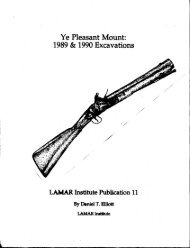Stirring Up a Hornet's Nest: - UGA Laboratory of Archaeology ...
Stirring Up a Hornet's Nest: - UGA Laboratory of Archaeology ...
Stirring Up a Hornet's Nest: - UGA Laboratory of Archaeology ...
Create successful ePaper yourself
Turn your PDF publications into a flip-book with our unique Google optimized e-Paper software.
his family, along with several hundred other Patriot refugees to the mountains. In their absence the British<br />
and Loyalists destroyed many settlements and forts in Wilkes County.<br />
Clarke’s second Georgia plantation, called “Woburn” was located in present-day Lincoln County, portions<br />
<strong>of</strong> which were inundated by the construction <strong>of</strong> Lake Clark Hill (McCall 2004, Volume I: 14; Ebel 1996).<br />
This plantation was formerly the plantation <strong>of</strong> Colonel Thomas Waters, a prominent Loyalist and<br />
Provincial Ranger <strong>of</strong>ficer whose land was confiscated by the Georgia government. Clarke was given<br />
Waters’ plantation by the State <strong>of</strong> Georgia as a gift for his service to the state in the American Revolution<br />
and he was living there by 1782 (Candler 1908, Volume III:116).<br />
Elijah Clarke served the Patriot cause as a militia <strong>of</strong>ficer throughout the American Revolution. He was<br />
commissioned as a Lieutenant Colonel in Colonel John Stewart’s 1 st Battalion in 1777. Stewart’s Battalion<br />
was authorized for two years <strong>of</strong> service and it participated in the East Florida campaign in May and June,<br />
1778. The 1 st and 2 nd Battalions <strong>of</strong> Georgia minutemen were <strong>of</strong>ficially disbanded on March 1, 1778, prior to<br />
participation in the East Florida campaign, where, at the battle <strong>of</strong> Alligator Creek, Clarke was badly<br />
wounded. Clarke recuperated from his wounds at Sunbury, Georgia and later returned to Wilkes County.<br />
Clarke received another commission as a Lieutenant-Colonel in the Wilkes County militia only a few<br />
weeks before the battle <strong>of</strong> Kettle Creek, on January 26, 1779 (Candler 1908, Volume 2:136-137; 2001). He<br />
was second in command <strong>of</strong> the Georgia militia at Kettle Creek. Clarke is credited with achieving the rout<br />
<strong>of</strong> the Loyalists at Kettle Creek after he pursued them across the creek and to a hill on its western side. That<br />
status was confirmed by the present research.<br />
Colonel John Dooly’s death in July 1780 led to Elijah Clarke’s advancement in the Georgia militia for the<br />
duration <strong>of</strong> the war. Clarke commanded Georgia and South Carolina militia troops at battles in Augusta,<br />
Savannah, and numerous engagements in South Carolina and North Carolina. He also participated in<br />
Colonel Pickens’ campaign against the Lower Cherokee towns. Following the first battle <strong>of</strong> Augusta in<br />
September1780, Clarke led a group <strong>of</strong> Wilkes County refugees to the Blue Ridge Mountains, where they<br />
joined with other Patriots. That group <strong>of</strong> soldiers, also known as the Overmountain men, helped to turn the<br />
tide <strong>of</strong> the war against the British with their participation in the battles <strong>of</strong> King’s Mountain, Cowpens and<br />
other places in the Carolinas. Elijah Clarke is Georgia’s most celebrated Revolutionary War hero. Clarke<br />
continued to serve as a military leader in the Georgia militia after the American Revolution. His creation <strong>of</strong><br />
a “Trans-Oconee Republic” was received by the U.S. Government as a treasonous act. In early 1790 he led<br />
the Georgia troops against the Creek Indians in several engagements. General Elijah Clarke died on<br />
December 15, 1799 (McCall 2004, Volume I: 14).<br />
Several portraits <strong>of</strong> Elijah Clarke have survived. All <strong>of</strong> these are likely derived from an original oil on<br />
ivory miniature portrait <strong>of</strong> Elijah Clarke, possibly painted by noted artist Rembrandt Peale. Peale was born<br />
in 1778 and he achieved fame when he painted George Washington in 1795. Numerous examples <strong>of</strong><br />
miniature portraits on ivory by Peale are known to exist.<br />
One early oil portrait <strong>of</strong> Elijah Clarke is privately owned by a family descendant and is housed in Mobile,<br />
Alabama (Louise S. Thoman personal communication February 14, 2009). It is shown in Figure 9.<br />
Thoman, who has researched the provenance <strong>of</strong> this artwork, suspects that the first oil on canvas portrait<br />
was made from an ivory miniature for which Elijah Clarke sat, shortly after the end <strong>of</strong> the American<br />
Revolution. Two additional paintings were commissioned based on this portrait, one for Drury Thompson<br />
and the other for Ann Clark Campbell. Ann Clark Campbell, daughter <strong>of</strong> Elijah Clarke’s son John, wrote to<br />
Lyman C. Draper in 1872 with some information about the portrait, which is contained in the Draper<br />
manuscripts. In excerpt from this letter Ann Campbell stated,<br />
I have heard my Mother say that my grandfather Gen'l Clark was one <strong>of</strong> the handsomest & most courtly men in his<br />
appearance and manners she ever saw. He was a little over six feet in height, and had blue or rather gray eyes, brown or<br />
sandy hair, with a fair complexion. The portrait I have was taken from a miniature painting for [sic] Genl Elijah Clark soon<br />
after the close <strong>of</strong> the war. His children not thinking it did him justice refused to take it. But my mother insisted upon<br />
keeping it. Mr. Drury Thompson, my cousin, hearing it was in my possession, had a portrait for himself & one for me taken<br />
from it. The only change made was in the color <strong>of</strong> the coat. The miniature represented the old revolutionary uniform <strong>of</strong> pale<br />
blue & buff, the artist claimed the privelege <strong>of</strong> changing it to a dark blue (Campbell 1872, in Draper Manuscripts).<br />
50










